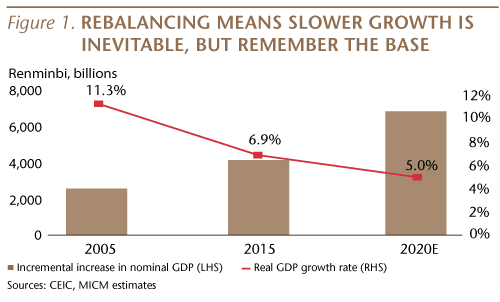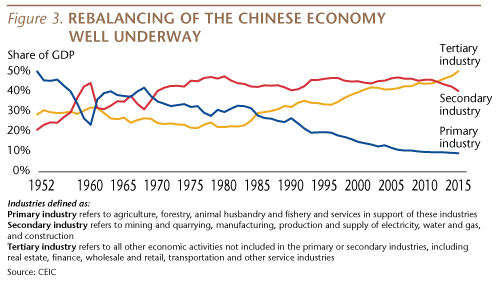Managing Chinese Volatility
China’s economy continues to decelerate, but gradually and while generating a much bigger incremental expansion in GDP than a decade ago. The old economy is weak, but the consumer and services part—the biggest part of the economy—remains healthy. Recent volatility is likely to continue, as the economy becomes more market-oriented and regulators experiment with unfamiliar tools.
As expected, every important economic statistic in China grew a bit more slowly last year, according to official data published on January 18th, but the consumer and services part of the economy—the biggest part of the economy—remained very healthy. Growth will continue to decelerate gradually in the coming years, but the risks of a hard landing are very low.
GDP Growth Really isn’t Important
Headlines may be shouting that China’s 2015 GDP growth rate was the slowest since the Tang Dynasty, or at least for about 25 years, but that really isn’t important.
As I’ve been writing for many years, it is inevitable that most Chinese economic statistics will grow at gradually slower year-over-year (YoY) rates for many years to come. This is due in part to structural changes, including a shrinking workforce, and because after three decades of 10% growth, the base has become too big to sustain double-digit expansion.
While GDP rose by “only” 6.9% last year, that came on a base that was about 300% bigger than it was a decade ago (when GDP growth was 11.3%), meaning that the incremental expansion in China’s economy last year was about 60% bigger than it was back in the day. As a result, last year’s slower growth rate actually provided a larger opportunity for firms selling goods and services in China, as well as a better opportunity for us to invest in those firms.

Moreover, GDP growth may be the least important statistic in China. After all, we don’t make investment decisions in the U.S. or Europe based on GDP growth rates. As in other markets, the important stats in China concern employment, income, inflation and consumer spending. While income and retail sales grew a bit more slowly last year, those numbers were very healthy and should remain healthy this year.
In the fourth quarter of 2015, real (inflation-adjusted) income rose 6.5%, compared to an increase of 7.5% in 4Q14. For all of last year, real income rose 7.4%, compared to 8% in 2014.
The core consumer price index (CPI), which excludes volatile food and energy prices, rose 1.6% last year, on par with the historical average. The purchasing price index for industrial inputs, or PPI, was in deflation last year, but that reflects sharply lower global commodity prices rather than domestic issues. I’m not worried about deflation in China.
Consumer Story to Remain Strong
I expect the consumer story to remain strong for several reasons. Income, while decelerating along with the rest of the economy, should grow by more than 6% in real terms. This follows a decade of more than 130% real income growth, compared to about 8% growth in real per capita disposable personal income in the U.S. over the same period. I expect another year of moderate consumer price inflation, at about 1.5%. Household debt is very low, and the savings rate very high.
All of this should contribute to an increase in the growth rate of real retail sales of roughly 10%. A bit slower than last year’s pace, but still very fast.

Rebalancing Well Underway
While the consumer story remains strong, China’s old economy was weak last year, and that will continue this year, especially in heavy industries such as steel and cement, as China has passed its peak in the growth of construction of infrastructure and new homes. But manufacturing has not collapsed, with a private survey revealing that factory wages were up 5% to 6% in 4Q15 (compared to 6% to 8% a year earlier), reflecting a fairly tight labor market. Crude oil imports by volume rose 9%, and the volume of copper imports was up 12%.
More importantly, few investors recognize that 2015 was the fourth consecutive year in which the manufacturing and construction part of the economy was smaller than the consumption and services part. Consumption accounted for about two-thirds of GDP growth, illustrating that the economy has rebalanced away from a dependence on exports, heavy industry and investment, and has, in my view, become the world’s best consumption story.
Last year, for the first time ever, services and consumption (the tertiary* part of the economy) accounted for more than half of China’s GDP, at 50.5%, up from 41.4% a decade ago. This mitigates weakness in manufacturing and construction (the secondary* part), and, if this rebalancing continues, it should mean that macro deceleration will be gradual.

Markets and Consumers
China’s domestic stock market—which has always been extremely volatile—has never been highly correlated to the broader economy. Since 1994, the Shanghai Composite Index has experienced 32 bear markets (a drop of 20% or more), compared to only two such falls in the S&P 500 Index over that time.
Just a month ago, at the end of 2015, the Shanghai Composite was one of the world’s best-performing indices for the full year, while so far this month it is one of the worst.
Chinese understand how volatile their market is, so few of them participate: there are only about 50 million active trading accounts, equal to 7% of China’s urban population. And 73% of those accounts have less than US$15,000 in them, while fewer than 1% of active accounts have more than US$1 million.
That helps explain why consumers shrugged off the recent A-share market volatility. In the first half of 2015, when the Shanghai Composite was booming, real retail sales rose 10.5% YoY, while in 2H15, when the market index was down sharply, real retail sales were up by a slightly faster pace, 10.7%. New home sales rose 4.5% on a volume basis during the A-share’s first half rally, but increased 8.5% in 2H15, after the index peaked in mid-June.
Capital Outflows
There were significant capital outflows in recent months, sparked by exchange rate volatility and uncertainty. But foreign exchange reserve levels remain very high, at US$3.3 trillion, or equal to 24 months of China’s 2015 imports (compared to a benchmark of reserves equal to three months of imports). To put this figure into context, the country with the next highest level of reserves, Japan, holds US$1.2 trillion.
I believe outflows will slow over the coming months, once markets get accustomed to Beijing’s new approach to its exchange rate: devaluing the renminbi (RMB) against the U.S. dollar in response to dollar strength, but keeping the RMB relatively stable against a trade-weighted basket of currencies. This explains why in 2015, the RMB depreciated by 5.8% against the dollar but appreciated by 0.9% against the basket of currencies. Unfortunately, Beijing has done a terrible job explaining this new exchange rate strategy.
It is important to note that while capital outflows have been significant, they have been due in part to Chinese corporates repaying offshore foreign-currency loans, to valuation changes, to Beijing’s intervention in the offshore RMB market, known as CNH, and because of reduced dollar inflows as more Chinese firms hold the foreign currency they earn offshore. In my view, however, we have not seen significant capital flight, which we define as Chinese selling their assets, such as real estate and businesses, in order to move their wealth offshore. We base this view on anecdotal conversations with our mainland contacts, as well as on data showing that last year in Beijing and Shanghai—cities with the largest share of residential real estate speculation—prices of both new homes and those on the secondary market all rose by 10% or more.
It is also worth noting that capital outflows do not appear to have had a material impact on liquidity within China. The seven-day Shanghai Interbank Offered Rate (Shibor, an average of the rate at which major banks say they will lend) was 2.4% at the end of last year, down from 4.6% at the end of 2014. Broad money supply (M2) rose 13.3% at the end of last year, compared to 12.2% a year ago.
Volatility and Valuations
There is little doubt that 2016 will be another year of Chinese volatility. The A-share market has, throughout its history, been incredibly volatile. As the real economy becomes more market-oriented, driven by privately owned rather than state-owned firms, there will be more volatility. As policymakers and regulators experiment with unfamiliar tools designed to support economic rebalancing, their mistakes will add to that volatility.
But short-term volatility is manageable with a long-term investment horizon, especially if we believe China’s economic policymakers are pragmatic and are headed in the right direction. And with the median forward price-to-earnings ratio (P/E) for all of Matthews Asia’s China holdings at 13, cheaper than the S&P 500 Index, we see opportunity.*
Andy Rothman
Investment Strategist
Matthews Asia
*As of the end of December 2015
